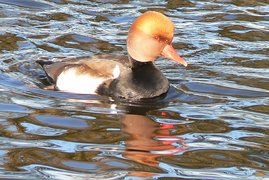

Perivale Wood - Jewel in the Crown
Perivale Wood is without doubt a jewel in the crown of West London's wildlife sites and is the Borough of Ealing's 'flagship' nature reserve. It is an area of ancient oak/bluebell woodland hidden away in the suburbs of Ealing. It is the second oldest nature reserve in Britain and is owned and managed by the Selborne Society, the country's oldest nature conservation organisation. It is the first known site in the world for two species of fungi.
The Bluebells
Perivale Wood is best known for its bluebells - and rightly so. Although they occur in a few other countries in NW Europe, England is very much their "headquarters". Perivale Wood is one of the finest examples of a "bluebell wood". Spring is the most beautiful time as the dappled sunlight comes through the newly emerging leaves of the standard trees and coppiced hazel onto the carpet of over 4 million bluebells.
SSSI Designation
Perivale Wood used to be a "Site of Special Scientific Interest " (SSSI). This designation is given to the finest wildlife sites by the Government's conservation agency, English Nature. The designation is intended to afford statutory protection to such sites. Perivale Wood has lost none of its value since it became a Nature Reserve and was designated as a SSSI. Indeed, with the continued destruction of habitats and discovery of its unique fungi, it is now more important than ever. Nonetheless, English Nature has removed its SSSI status. Despite repeated requests, no clear explanation was ever given. The real reason is almost certainly that English Nature do want too many SSSIs. Each extra site tends to increase their workload, as English Nature then have to monitor its management and will have to comment if there are any threats to that site. They pointed out that there were other 'good' oak woodlands in the London area.
The Habitats
Perivale Wood is an 11 hectare (27 acre) area of ancient oak woodland in west London. It is bounded to the north by the Grand Union Canal, and to the south by a railway embankment and houses. To the east and west are warehouses, industrial units and recreational open space.
It includes a rich variety of habitats:
7 hectares (ha) of ancient mixed oak woodland
2 ha of grazed pasture land
1 ha of damp scrub
1 ha of relatively recently disturbed land, which has a very different vegetation from the rest of the wood
3 ponds and 2 small streams
Nearly half a km of hedgerow
The Wildlife
Perivale Wood is probably the richest wildlife site in the borough - it is certainly the best studied and recorded. Within the Reserve we have recorded over the years:
1000 species of fungi
300 species of moths
30 species of molluscs
17 species of mammals
24 species of trees
350 species of vascular plants
over 60 species of mosses and liverworts
115 species of birds, of which 40 breed regularly
many insects and other invertebrates (with untold numbers still to be recorded)

The Selborne Society
The Selborne Society was founded in 1885 to commemorate the eighteenth century naturalist Gilbert White, of Selborne in Hampshire. It was originally a national organisation, founded to continue the traditions of this pioneer of environmental study by correspondence between members about their observations of natural history. Today's Selborne Society was originally the Brent Valley branch of the national Society, and continues the work of its founders, observing and recording wildlife in part of west London and managing and conserving Perivale Wood Local Nature Reserve as the Gilbert White Memorial.
To find out more about Perivale Wood or to join the Selborne Society, visit Perivale Wood or send an e-mail to d.bender@ucl.ac.uk








